Abstract
We present a hypothesis for the loss of acetylcholine in Alzheimer's disease that is based on two recent experimental results: that beta-amyloid causes leakage of choline across cell membranes and that decreased production of acetylcholine increases the production of beta-amyloid. According to the hypothesis, an increase in beta-amyloid concentration caused by proteolysis of the amyloid precursor protein results in an increase in the leakage of choline out of cells. This leads to a reduction in intracellular choline concentration and hence a reduction in acetylcholine production. The reduction in acetylcholine production, in turn, causes an increase in the concentration of beta-amyloid. The resultant positive feedback between decreased acetylcholine and increased beta-amyloid accelerates the loss of acetylcholine. We compare the predictions of the choline-leakage hypothesis with a number of experimental observations. We also approximate it with a pair of ordinary differential equations. The solutions of these equations indicate that the loss of acetylcholine is very sensitive to the initial rate of beta-amyloid production.
Full text
PDF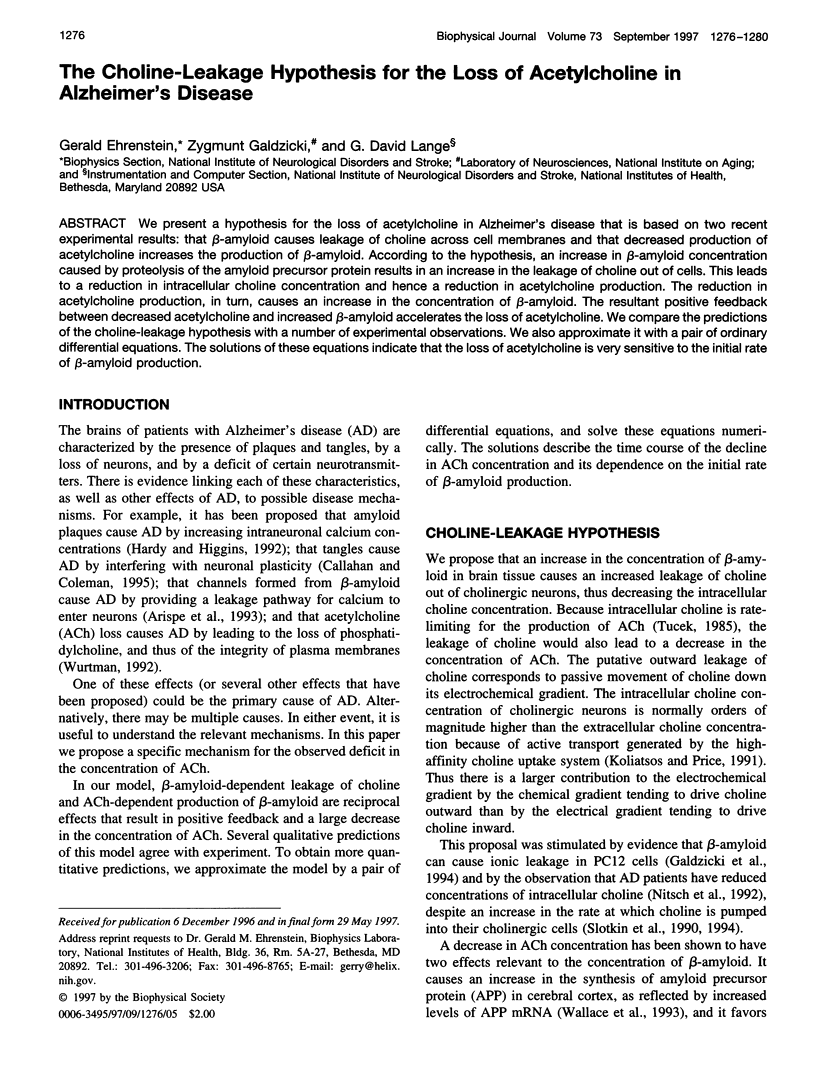
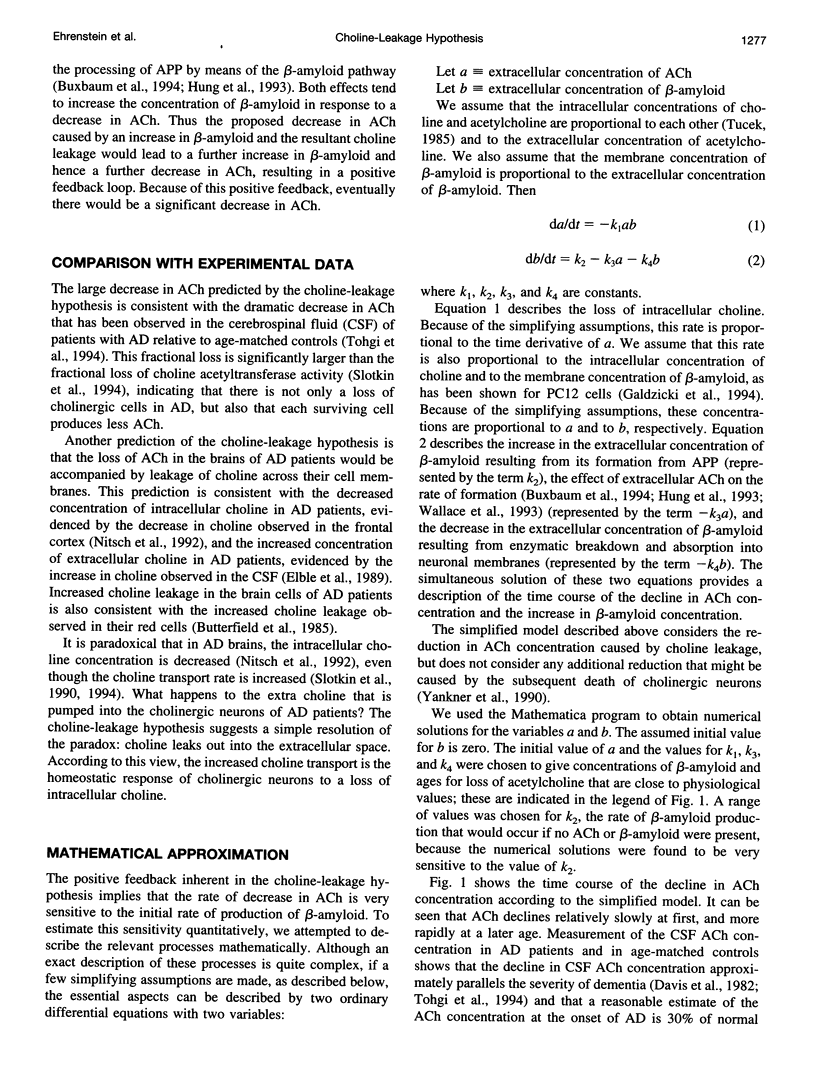
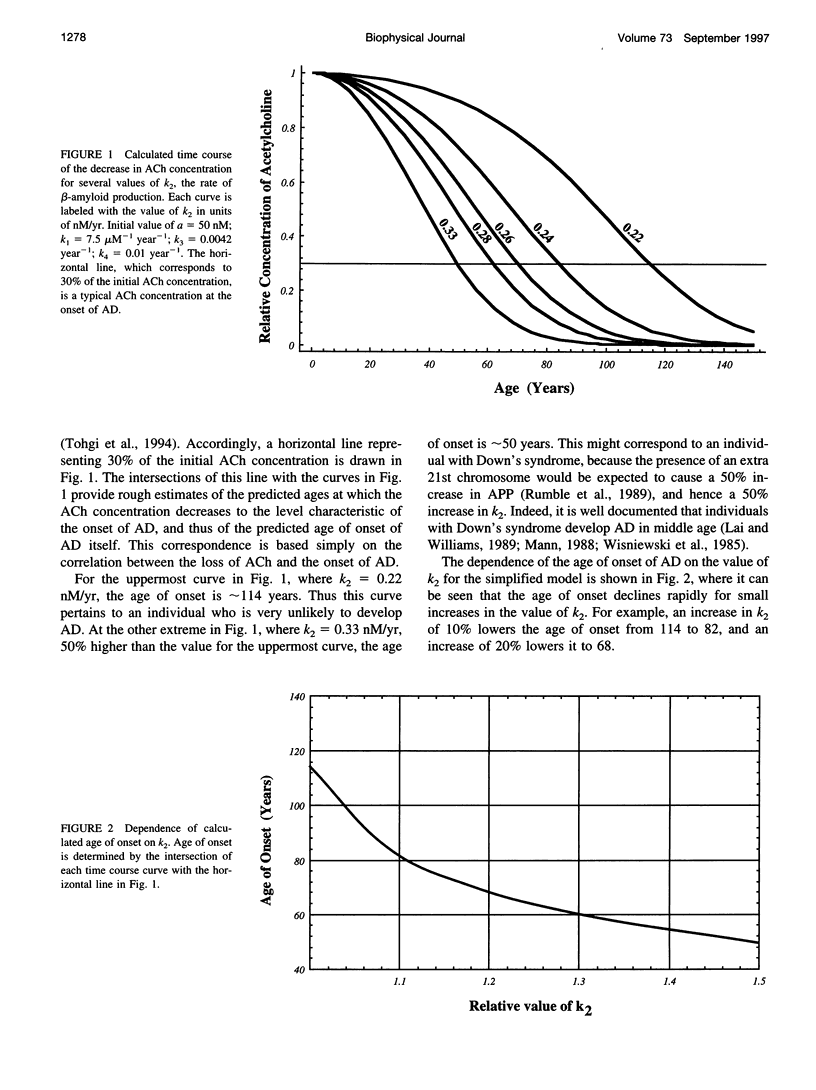
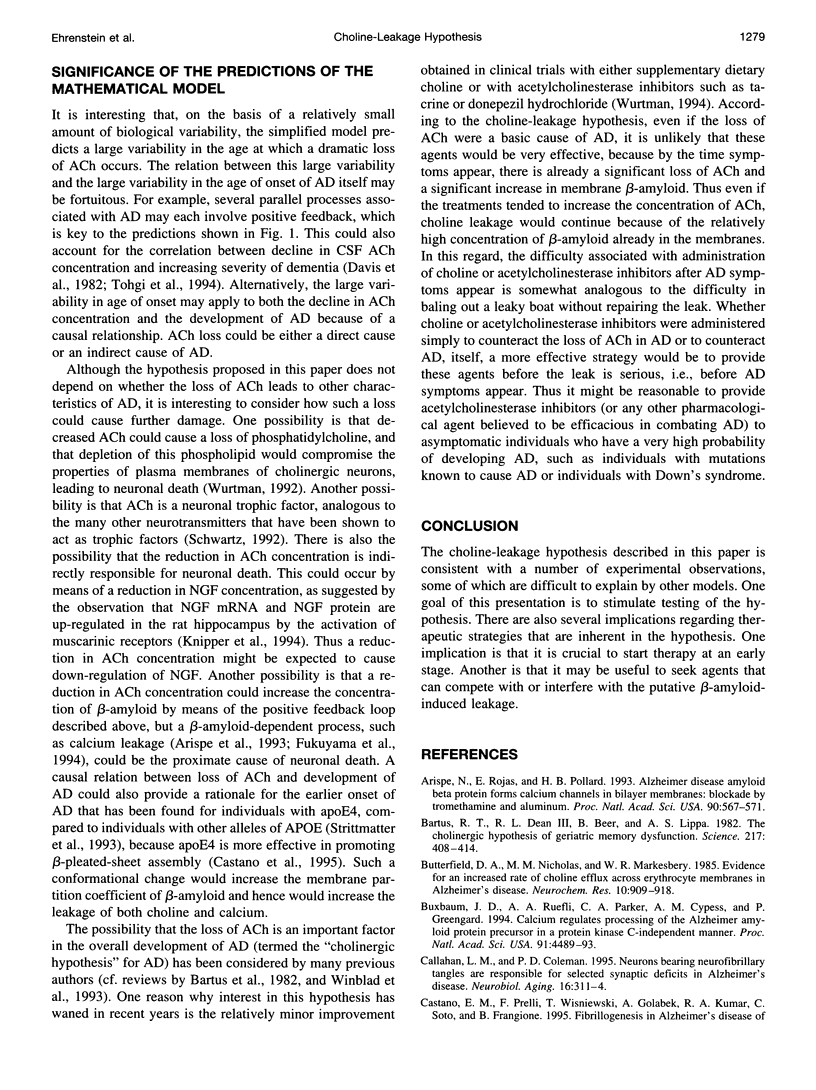
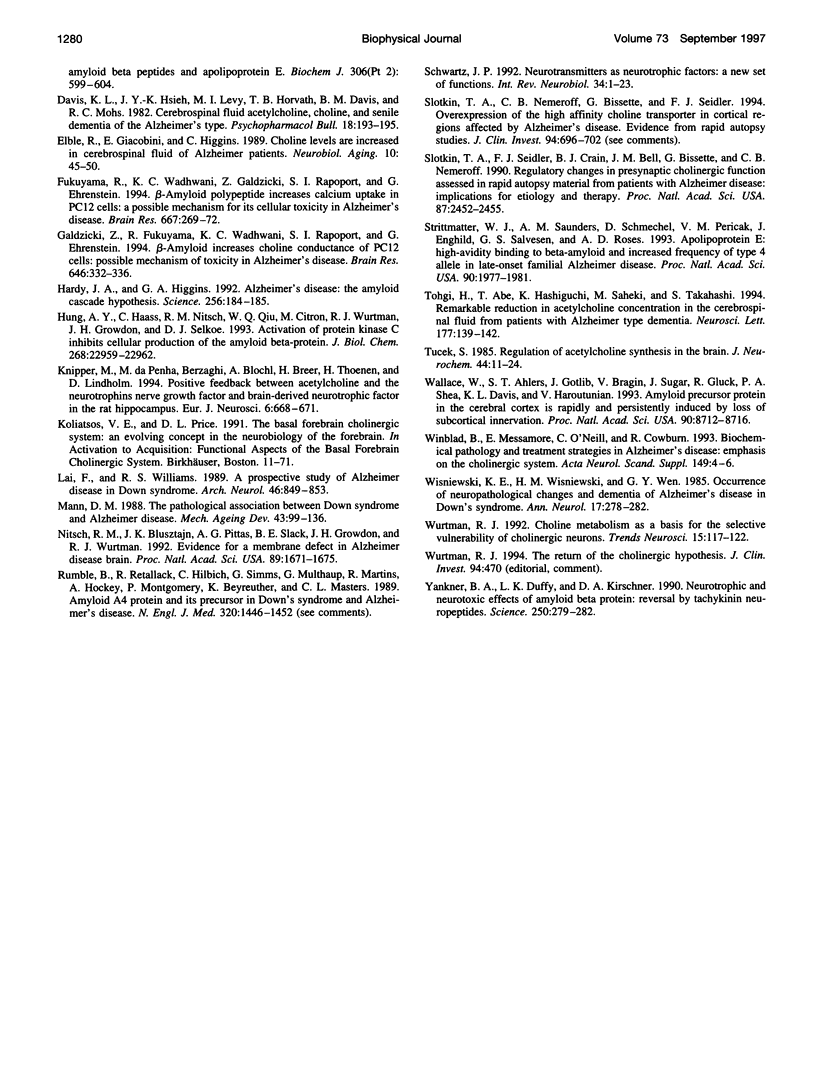
Selected References
These references are in PubMed. This may not be the complete list of references from this article.
- Arispe N., Rojas E., Pollard H. B. Alzheimer disease amyloid beta protein forms calcium channels in bilayer membranes: blockade by tromethamine and aluminum. Proc Natl Acad Sci U S A. 1993 Jan 15;90(2):567–571. doi: 10.1073/pnas.90.2.567. [DOI] [PMC free article] [PubMed] [Google Scholar]
- Bartus R. T., Dean R. L., 3rd, Beer B., Lippa A. S. The cholinergic hypothesis of geriatric memory dysfunction. Science. 1982 Jul 30;217(4558):408–414. doi: 10.1126/science.7046051. [DOI] [PubMed] [Google Scholar]
- Butterfield D. A., Nicholas M. M., Markesbery W. R. Evidence for an increased rate of choline efflux across erythrocyte membranes in Alzheimer's disease. Neurochem Res. 1985 Jul;10(7):909–918. doi: 10.1007/BF00964628. [DOI] [PubMed] [Google Scholar]
- Buxbaum J. D., Ruefli A. A., Parker C. A., Cypess A. M., Greengard P. Calcium regulates processing of the Alzheimer amyloid protein precursor in a protein kinase C-independent manner. Proc Natl Acad Sci U S A. 1994 May 10;91(10):4489–4493. doi: 10.1073/pnas.91.10.4489. [DOI] [PMC free article] [PubMed] [Google Scholar]
- Callahan L. M., Coleman P. D. Neurons bearing neurofibrillary tangles are responsible for selected synaptic deficits in Alzheimer's disease. Neurobiol Aging. 1995 May-Jun;16(3):311–314. doi: 10.1016/0197-4580(95)00035-d. [DOI] [PubMed] [Google Scholar]
- Castano E. M., Prelli F., Wisniewski T., Golabek A., Kumar R. A., Soto C., Frangione B. Fibrillogenesis in Alzheimer's disease of amyloid beta peptides and apolipoprotein E. Biochem J. 1995 Mar 1;306(Pt 2):599–604. doi: 10.1042/bj3060599. [DOI] [PMC free article] [PubMed] [Google Scholar]
- Davis K. L., Hsieh J. Y., Levy M. I., Horvath T. B., Davis B. M., Mohs R. C. Cerebrospinal fluid acetylcholine, choline, and senile dementia of the Alzheimer's type. Psychopharmacol Bull. 1982 Oct;18(4):193–195. [PubMed] [Google Scholar]
- Elble R., Giacobini E., Higgins C. Choline levels are increased in cerebrospinal fluid of Alzheimer patients. Neurobiol Aging. 1989 Jan-Feb;10(1):45–50. doi: 10.1016/s0197-4580(89)80009-0. [DOI] [PubMed] [Google Scholar]
- Fukuyama R., Wadhwani K. C., Galdzicki Z., Rapoport S. I., Ehrenstein G. beta-Amyloid polypeptide increases calcium-uptake in PC12 cells: a possible mechanism for its cellular toxicity in Alzheimer's disease. Brain Res. 1994 Dec 26;667(2):269–272. doi: 10.1016/0006-8993(94)91505-9. [DOI] [PubMed] [Google Scholar]
- Galdzicki Z., Fukuyama R., Wadhwani K. C., Rapoport S. I., Ehrenstein G. beta-Amyloid increases choline conductance of PC12 cells: possible mechanism of toxicity in Alzheimer's disease. Brain Res. 1994 May 23;646(2):332–336. doi: 10.1016/0006-8993(94)90101-5. [DOI] [PubMed] [Google Scholar]
- Hardy J. A., Higgins G. A. Alzheimer's disease: the amyloid cascade hypothesis. Science. 1992 Apr 10;256(5054):184–185. doi: 10.1126/science.1566067. [DOI] [PubMed] [Google Scholar]
- Hung A. Y., Haass C., Nitsch R. M., Qiu W. Q., Citron M., Wurtman R. J., Growdon J. H., Selkoe D. J. Activation of protein kinase C inhibits cellular production of the amyloid beta-protein. J Biol Chem. 1993 Nov 5;268(31):22959–22962. [PubMed] [Google Scholar]
- Knipper M., da Penha Berzaghi M., Blöchl A., Breer H., Thoenen H., Lindholm D. Positive feedback between acetylcholine and the neurotrophins nerve growth factor and brain-derived neurotrophic factor in the rat hippocampus. Eur J Neurosci. 1994 Apr 1;6(4):668–671. doi: 10.1111/j.1460-9568.1994.tb00312.x. [DOI] [PubMed] [Google Scholar]
- Lai F., Williams R. S. A prospective study of Alzheimer disease in Down syndrome. Arch Neurol. 1989 Aug;46(8):849–853. doi: 10.1001/archneur.1989.00520440031017. [DOI] [PubMed] [Google Scholar]
- Mann D. M. The pathological association between Down syndrome and Alzheimer disease. Mech Ageing Dev. 1988 May;43(2):99–136. doi: 10.1016/0047-6374(88)90041-3. [DOI] [PubMed] [Google Scholar]
- Nitsch R. M., Blusztajn J. K., Pittas A. G., Slack B. E., Growdon J. H., Wurtman R. J. Evidence for a membrane defect in Alzheimer disease brain. Proc Natl Acad Sci U S A. 1992 Mar 1;89(5):1671–1675. doi: 10.1073/pnas.89.5.1671. [DOI] [PMC free article] [PubMed] [Google Scholar]
- Rumble B., Retallack R., Hilbich C., Simms G., Multhaup G., Martins R., Hockey A., Montgomery P., Beyreuther K., Masters C. L. Amyloid A4 protein and its precursor in Down's syndrome and Alzheimer's disease. N Engl J Med. 1989 Jun 1;320(22):1446–1452. doi: 10.1056/NEJM198906013202203. [DOI] [PubMed] [Google Scholar]
- Schwartz J. P. Neurotransmitters as neurotrophic factors: a new set of functions. Int Rev Neurobiol. 1992;34:1–23. doi: 10.1016/s0074-7742(08)60096-3. [DOI] [PubMed] [Google Scholar]
- Slotkin T. A., Nemeroff C. B., Bissette G., Seidler F. J. Overexpression of the high affinity choline transporter in cortical regions affected by Alzheimer's disease. Evidence from rapid autopsy studies. J Clin Invest. 1994 Aug;94(2):696–702. doi: 10.1172/JCI117387. [DOI] [PMC free article] [PubMed] [Google Scholar]
- Slotkin T. A., Seidler F. J., Crain B. J., Bell J. M., Bissette G., Nemeroff C. B. Regulatory changes in presynaptic cholinergic function assessed in rapid autopsy material from patients with Alzheimer disease: implications for etiology and therapy. Proc Natl Acad Sci U S A. 1990 Apr;87(7):2452–2455. doi: 10.1073/pnas.87.7.2452. [DOI] [PMC free article] [PubMed] [Google Scholar]
- Strittmatter W. J., Saunders A. M., Schmechel D., Pericak-Vance M., Enghild J., Salvesen G. S., Roses A. D. Apolipoprotein E: high-avidity binding to beta-amyloid and increased frequency of type 4 allele in late-onset familial Alzheimer disease. Proc Natl Acad Sci U S A. 1993 Mar 1;90(5):1977–1981. doi: 10.1073/pnas.90.5.1977. [DOI] [PMC free article] [PubMed] [Google Scholar]
- Tohgi H., Abe T., Hashiguchi K., Saheki M., Takahashi S. Remarkable reduction in acetylcholine concentration in the cerebrospinal fluid from patients with Alzheimer type dementia. Neurosci Lett. 1994 Aug 15;177(1-2):139–142. doi: 10.1016/0304-3940(94)90064-7. [DOI] [PubMed] [Google Scholar]
- Tucek S. Regulation of acetylcholine synthesis in the brain. J Neurochem. 1985 Jan;44(1):11–24. doi: 10.1111/j.1471-4159.1985.tb07106.x. [DOI] [PubMed] [Google Scholar]
- Wallace W., Ahlers S. T., Gotlib J., Bragin V., Sugar J., Gluck R., Shea P. A., Davis K. L., Haroutunian V. Amyloid precursor protein in the cerebral cortex is rapidly and persistently induced by loss of subcortical innervation. Proc Natl Acad Sci U S A. 1993 Sep 15;90(18):8712–8716. doi: 10.1073/pnas.90.18.8712. [DOI] [PMC free article] [PubMed] [Google Scholar]
- Winblad B., Messamore E., O'Neill C., Cowburn R. Biochemical pathology and treatment strategies in Alzheimer's disease: emphasis on the cholinergic system. Acta Neurol Scand Suppl. 1993;149:4–6. doi: 10.1111/j.1600-0404.1993.tb04244.x. [DOI] [PubMed] [Google Scholar]
- Wisniewski K. E., Wisniewski H. M., Wen G. Y. Occurrence of neuropathological changes and dementia of Alzheimer's disease in Down's syndrome. Ann Neurol. 1985 Mar;17(3):278–282. doi: 10.1002/ana.410170310. [DOI] [PubMed] [Google Scholar]
- Wurtman R. J. Choline metabolism as a basis for the selective vulnerability of cholinergic neurons. Trends Neurosci. 1992 Apr;15(4):117–122. doi: 10.1016/0166-2236(92)90351-8. [DOI] [PubMed] [Google Scholar]
- Wurtman R. J. The return of the cholinergic hypothesis. J Clin Invest. 1994 Aug;94(2):470–470. doi: 10.1172/JCI117356. [DOI] [PMC free article] [PubMed] [Google Scholar]
- Yankner B. A., Duffy L. K., Kirschner D. A. Neurotrophic and neurotoxic effects of amyloid beta protein: reversal by tachykinin neuropeptides. Science. 1990 Oct 12;250(4978):279–282. doi: 10.1126/science.2218531. [DOI] [PubMed] [Google Scholar]


